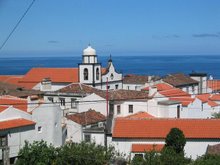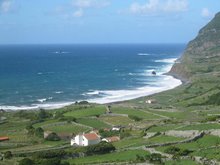Between them, the Portuguese national airline TAP Portugal and the Azores airline SATA have about four or five flights a day from Lisbon to three of the larger islands (Sao Miguel, Terceira and Faial). From these three, you can then fly on to any of the other six islands the same day on a SATA Bombardier Dash 8-Q400, the regional propliner of choice:-
Thus, you can get to Flores from Lisbon in less than 6 hours. But it was different 50 years ago (which, I would remind people of my age, is as recently as the 1960s) when you had to go to the Azores on a ship - slower but a lot more fun.
The shipping company was called Empresa Insulana de Navegção ("Island Shipping Company") and it served the Azores and Madeira from Lisbon in the days before mass air travel. In 1961, EIN made its last big investment in passenger ships by commissioning two new vessels.
 |
| MS Funchal - photo credit Luis Miguel Correia |
The first - pictured above - was called Funchal (after the capital of Madeira). Built at the Elsinore Shipyard in Denmark and carrying 400 passengers at 20 knots (23mph/37kmh), she sailed from Lisbon to Madeira and the larger islands of the Azores. She was the equivalent of today's TAP and SATA Airbuses except the journey by sea took two days instead two hours by air nowadays.
The other new ship of 1961 was a mini version of the Funchal called Ponta Delgada (named after the capital of the Azores). Her role was to take passengers out to the smaller islands of the Azores and thus she was the equivalent of today's SATA Q400s.
That's a classic picture of the Ponta Delgada lying off Fajã Grande in the 1960s. There was no pier a ship could lie alongside at Flores before the 1990s so passengers had to be ferried out in a small launch as you can see here. (I assumed the ships lay off Santa Cruz on the east coast of Flores but perhaps they made additional calls round the island or maybe there was some reason why the PD could not call at SC that day.) The picture above is one of a very interesting series of old photos of Fajã Grande you can see on Facebook (I hope that link works but as I'm not much of Facebooker, I'm not sure.)
 |
| The Ponta Delgada alongside at Sao Jorge in the 70s - phot credit Luis Miguel Correia |
That picture of the view from the Funchal's bridge is from Bruce Peter's blog where you can find lots of other pictures of her. And if you fancy a cruise amongst 60s Scandinavian decor, here's the link to her owners - Classic International Cruises. It looks all very spit and polish and you get the distinct impression the captain of a CIC ship wouldn't be careless enough to bang his vessel into a bit of the scenery. And if he did, that he'd have the decency to hang around and face the music rather scarper on the first available lifeboat. (I'm at risk of digressing into stereotypical Italian cowardice but they really do ask for it, don't they? As if Berlusconi wasn't enough of a role model, they had to invent Francesco Schettino just to ram the point home.)
 |
| Which lifeboat is the captain on? |
Regular "commenter" on this blog, Marisa Perreira, is from Graciosa but as a child in the 1970s she travelled to Flores most years to spend the summer with her grandmother in Fajã Grande. As there was no airport on Graciosa until 1981, that involved a sail on the Ponta Delgada which began with being taken out to the ship in a launch as Graciosa didn't boast a pier in the 70s either.
 |
| The Ponta Delgada at Ponta Delgada - photo credit Luis Miguel Correia |
But at least she didn't suffer from sea-sickness like her sister who didn't emerge from the cabin for the whole voyage. Marisa used to wander off round the ship and one particular memory is of leaning in through a hatch cover on the foredeck chatting to crewmen below when the tannoy announced "If anyone has seen a curly haired little girl ..." On being reunited, her mother informed her that the crew were apt to throw naughty children overboard!
 |
| Photo credit - Luis Miguel Correia |
 | ||
| The bar on the Ponta Delgada - photo credit Luis Miguel Correia |
 | ||
| Photo credit Luis Miguel Correia |
So, today, people come to Flores on the plane and "stuff" comes on the container ship once a fortnight. In the summer, there's a rather infrequent (once a week at most) ferry service subsidised by the Azorean Government. If it were up to me, I'd sooner they spent the money on lights at the airport that would allow SATA's planes to land after dark in winter.








5 comments:
:))))))
Well, thank you mr. King, that's lovely.
The reason why Ponta Delgada sometimes "made scale" (fazia escala) at Fajã-Grande was due to the weather conditions at Santa Cruz or Lajes pier.
http://picodavigia.blogs.iol.pt/2009/04/13/quando-o-carvalho-araujo-fazia-servico-na-faja-grande/
Here is an explanation about the call at Fajã's pier.
Marisa, thank you for sharing your story with Neil & Carol -- whom I also thank for retelling it on their blog! I wonder if my paternal great-grandparents (separately) departed from the Fajã Grande dock in the 1870s, ultimately heading to California...
Marisa, I so look forward to meeting you soon -- thank you for your help with references :-)
With the disclaimer that my family lied notoriously to me re certain aspects of its background -- including concealing its Portugueseness -- I offer the followin family anecdote:
Allegedly my dad's Azorean maternal grandfather rose to the rank of sailing ship captain in his seafaring days -- and never abandoned ship till absolutely everyone on board had safely disembarked. Ever. This was a point of morality and honor for ships' captains. Note too that in the dead of winter a few years ago, US Airways Captain Chesley "Sully" Sullenberger did not get off his jet that downed in New York City's Hudson River (after geese got sucked into all the engines, shutting the latter down) until he ascertained through repeated cabin searches that every single one of HIS passengers had safely gotten out.
The first time I visited Flores in 1973, I traveled from Horta to Santa Cruz Flores on the Ponta Delgada. We left Horta in the late afternoon and traveled overnight, landing first at Vila Nova, Corvo where we spent 3 or 4 hours off loading cargo and passengers. We then weighed anchor and made for Santa Cruz. The small boats came out to meet us and on the first one was my first cousin, Mariano, who I had never met before. When we got to the dock, I was met by Aunts. Uncles and cousins I was meeting for the first time. As I write this, the tears are running down my cheeks just thinking about that wonderful experience.One of the cousins who I had met before was my first cousin Francisco Vitorino Vasconcelos (known locally as "Padre Vitorino") who at that time was was Pastor of Nossa Sra da Conceicao in Santa Cruz. After a welcome meal at the Rectory, He drove us around the island to meet other cousins in Lomba and Fajazinha (where we stayed with my "Tia Felomina") The scenery boweled me over.
John Vasconcelos
Post a Comment